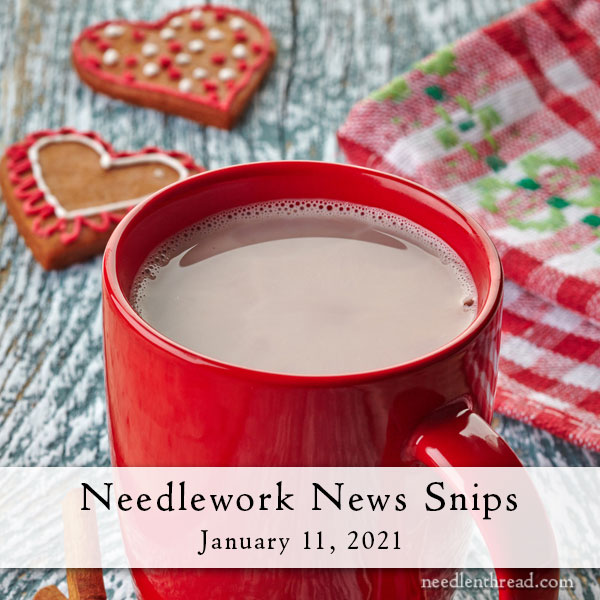Good morning and happy Monday!
Normally, I gather up a more extensive list of needlework resources when I share news snips, but these four artistic, inspirational, useful, or informative topics are worth taking a little time over. I wanted to share them with you on a Monday morning to give you the opportunity to enjoy them during the week as you have time.
Sometimes, for me, Monday morning is my quietest time. It’s when I do my weekly planning, but it’s also about the only time during the week that I spend time reviewing online needlework finds. Maybe you’re in the same boat.
Go grab a cup of something warm and cozy, and let’s have a little browse together!

Erica Wilson
Erica Wilson played a dominant role in enlivening the needle arts in the US (and even throughout the world) in the latter half of the 20th century. Winterthur Museum has constructed a wonderful online exhibition about Erica Wilson here. It’s very informative and inspiring!
Color Palette Converter
I’ve mentioned Stitch Palettes here on Needle ‘n Thread before. It’s a website where you can find terrific color combinations selected from photos and translated into useful modes, like RGB, CMYK, and HEX color codes, as well as DMC thread color codes. For the stitcher, this is useful!
This morning, Stitch Palettes has released a beta version of a palette generator, which allows you to upload your own favorite photos. It will select the dominant colors and convert them to DMC thread colors.
Careful! It’s fun… and a bit addicting!
Design, History, Embroidery, and Rabbit Holes
These last resources are for the historical embroidery enthusiast who is interested in the Gothic Revival era and the Arts & Crafts Movement, and beyond.
The first is a book that I don’t think I’ve shared with you before. It’s Pugin’s Glossary of Ecclesiastical Ornament and Costume, available online through Internet Archive.
If you’re looking for images and the meat of the matter when it comes to design, you’ll have to get about half way into the book. If you’re interested in reading and learning about that era in design (Gothic Revival in England), the whole book is worth reading.
Pugin was one of the greatest Gothic Revival architects and designers, and I find his artistic and design outlook fascinating. It’s interesting to realize the extent of his influence on future architecture and design styles – which definitely carried over into the embroidery and textile world. Pugin was a huge proponent of embroidery as a “vital and serious practice.” His influence (and the influence of other prominent Gothic Revival architects) prompted a revitalization in embroidery in the earlier 1800’s that carried into the latter part of that century and well into the 20th.
The Leek School of Embroidery, at Leek in Staffordshire, was established around 1879 by Thomas and Elisabeth Wardle, who were collaborators of William Morris, who in turn was strongly influenced by Pugin. Wardle & Company was a firm that dyed silk threads and fabrics used in embroidery and other textiles. Morris remained in Leek for about two years, learning processes for dying that he would later implement in his own company.
St. Edward the Confessor church in Leek features stained glass from the Morris company, but it also houses a collection of beautiful ecclesiastical embroideries that sprang from that era and beyond.
Here’s a collection of images from St. Edward the Confessor in Leek. You can click on them to see them larger.
This page from The Victorian Web concentrates on “The Hierarchy of Angels” embroidered panels from the church that were gifted by Elizabeth Wardle, a daughter of Thomas and Elisabeth. (Beautiful embroideries. And I love the feet! LOL!)
And this page offers links to other embroideries from the Look School of Embroidery.
If you start researching the beginning of the Gothic Revival movement in England in the first half of the 1800’s and you follow its influence into the 20th century (and beyond), you’ll find a rabbit hole of very interesting embroidery threads through all eras. It seems practically inexhaustible, these little connections here and there to this school and that influencer, and so on. It’s really one of my favorite rabbit holes!
And That’s All, Folks!
It’s not a huge list of explorations, but if you get into any of the above, you’ll find hours of inspiration, ideas, and information about needlework!
Hope your week is off to a great start! Later this week, we’ll talk about a goldwork and silk project and I’ll share other project progress, some tips, and more!